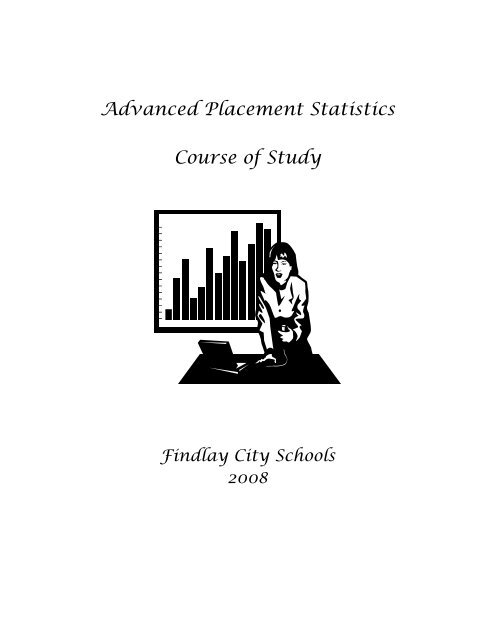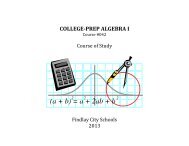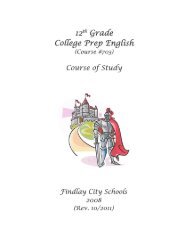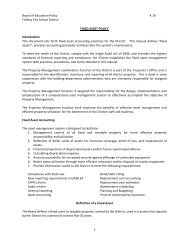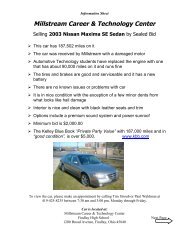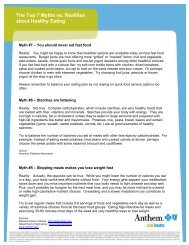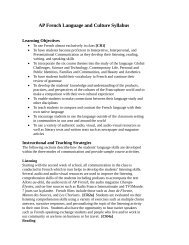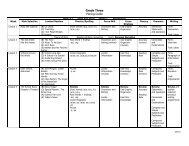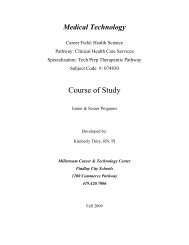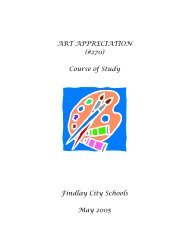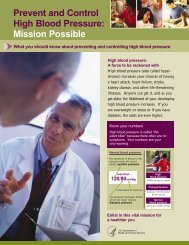AP Statistics - Findlay City Schools
AP Statistics - Findlay City Schools
AP Statistics - Findlay City Schools
Create successful ePaper yourself
Turn your PDF publications into a flip-book with our unique Google optimized e-Paper software.
Advanced Placement <strong>Statistics</strong>Course of Study<strong>Findlay</strong> <strong>City</strong> <strong>Schools</strong>2008
Mission StatementThe mission of the <strong>Findlay</strong> <strong>City</strong> <strong>Schools</strong>, a community partnershipcommitted to educational excellence, is to instill in each student theknowledge, skills and virtues necessary to be lifelong learners whorecognize their unique talents and purpose and use them in pursuitof their dreams and for service to a global society.This is accomplished through a passion for knowledge, discoveryand vision shared by students, families, staff and community.BeliefsOur beliefs form the ethical foundation of the <strong>Findlay</strong> <strong>City</strong> <strong>Schools</strong>.We believe….• every person has worth• every individual can learn• family is the most important influence on the development ofpersonal values.• attitude is a choice and always affects performance• motivation and effort are necessary to achieve full potential• honesty and integrity are essential for building trust.• people are responsible for the choices they make.• performance is directly related to expectations.• educated citizens are essential for the survival of thedemocratic process.• personal fulfillment requires the nurturing of mind, body andspirit.• every individual has a moral and ethical obligation tocontribute to the well-being of society.• education is a responsibility shared by students, family, staffand community.• the entire community benefits by investing its time, resourcesand effort in educational excellence.• a consistent practice of shared morals and ethics is essentialfor our community to thrive.
FI NDLAY HIGH SCHOOLMATHEMATICS<strong>AP</strong> <strong>Statistics</strong><strong>AP</strong> <strong>Statistics</strong> 1TextbookPeck, Roxy, Chris Olsen, and Jay Devore. Introduction to <strong>Statistics</strong> and Data Analysis,first edition. Pacific Grove, CA: Brooks/Cole, 2001.Technology• All students are expected to purchase a TI-83/TI-83+/TI-84 graphing calculator for usein class, at home, and on the <strong>AP</strong> Exam. Students will use their graphing calculatorextensively throughout the course.Throughout the course, the student will learn how to use their graphing calculator and theteacher will demonstrate the use of computers and/or computer output to enhance thedevelopment of statistical understanding through exploring and analyzing data, assessingmodels, and performing simulations.• All students have a copy of Fathom statistical software for use at home and fordemonstrations in class. Students will have occasional assignments that must becompleted using Fathom. After the <strong>AP</strong> exam, students will use Fathom daily when welearn multiple regression and ANOVA.• Various applets on the InternetCourse Outline(organized by chapters from textbook):Graphical displays include, but are not limited to using boxplots, dotplots, stemplots,back-to-back stemplots, histograms, frequency plots, parallel boxplots, and bar charts.Chapter 1: The Role of <strong>Statistics</strong>(total time: 5 days)• Activity: Sexual Discrimination• Introduction to key vocabulary• Sample Data for Introduction of Use of Graphing CalculatorChapter 2: The Data Analysis Process and Collecting Data Sensibly (total time: 14days)(Emphasis on sampling and experimentation.)
<strong>AP</strong> <strong>Statistics</strong> 2• Types of Data• Observational Studies• Activity: Sampling from the Gettysburg Address• Bias in sampling• Simple random samples• Stratified random samples• Activity: The River Problem• Cluster sampling• Designing experiments• Control groups• Treatments• Blocking• Random assignment• Replication• Activity: The Caffeine Experiment• The scope of inferenceChapter 3: Graphical Methods for Describing Data(total time: 4 days)• Displaying categorical data: pie and bar charts• Dotplots• Stemplots• Histograms• Describing the shape of a distribution
<strong>AP</strong> <strong>Statistics</strong> 3• Cumulative frequency graphsChapter 4: Numerical Methods for Describing Data(total time: 8 days)• Describing center: mean and median• Describing spread: range, interquartile range, and standard deviation• Boxplots• Outliers• Using the TI-83/ 84• The empirical rule• Standardized scores• Percentiles and quartiles• Transforming data• Using Fathom• Activity: Matching DistributionsChapter 5: Summarizing Bivariate Data(total time: 16 days)• Introduction to bivariate data• Making and describing scatterplots• The correlation coefficient• Properties of the correlation coefficient• Least squares regression line• Using the TI-83/84• Regression to the mean• Residual plots
<strong>AP</strong> <strong>Statistics</strong> 4• Standard deviation• Coefficient of determination• Unusual and influential points• Activity: Matching Scatterplots and Correlations• Applets: Demonstrating the effects of outliers• Using Fathom• Modeling nonlinear data: exponential and power transformationsMidterm: Chapters 1–5 (total time: 3 days)• Review Chapters 1–5 using previous <strong>AP</strong> questions• Introduce first semester projectChapter 6: Probability (total time: 13 days)• Definition of probability, outcomes, and events• Law of large numbers• Properties of probabilities• Conditional probability• Independence• Addition rule• Multiplication rule• Estimating probabilities using simulation• Using the TI-83/ 84for simulations• Activity: Cereal Boxes• Activity: ESP Testing• Activity: Senior parking
<strong>AP</strong> <strong>Statistics</strong> 5Chapter 7: Random Variables and Probability Distributions (total time: 18 days)• Properties of discrete random variables• Properties of continuous random variables• Expected value (mean) of a discrete random variable• Standard deviation of a discrete random variable• Linear functions and linear combinations of random variables• The binomial distribution• The geometric distribution• The normal distribution• Using the normal table• Using the TI-83/84 distribution menu• Combining normal random variables• Normal approximation to the binomialFirst Semester Final Exam (total time: 4 days)• Review using previous <strong>AP</strong> questionsChapter 8: Sampling Variability and Sampling Distributions (total time: 9 days)• Sampling distributions• Activity: How many textbooks?• Activity: Cents and the central limit theorem• Sampling distribution of the sample mean (including distribution of a differencebetween two independent sample means)• Sampling distribution of the sample proportion (including distribution of adifference between two independent sample proportions)Chapter 9: Estimation Using a Single Sample (total time: 10 days)
<strong>AP</strong> <strong>Statistics</strong> 6• Properties of point estimates: bias and variability• Confidence interval for a population proportion• Confidence interval for a population mean• Logic of confidence intervals• Meaning of confidence level• Activity: What does it mean to be 95% confident?• Finding sample size• Finite population correction factor• +4 confidence interval for a proportion• Confidence interval for a population mean• The t-distribution• Checking conditionsChapter 10: Hypothesis Testing Using a Single Sample (total time: 11 days)• Forming hypotheses• Logic of hypothesis testing• Type I and Type II errors• Hypothesis test for a population proportion• Test statistics and p-values• Activity: Kissing the right way• Two-sided tests• Hypothesis test for a population mean• Checking conditions• Power• Using Fathom
<strong>AP</strong> <strong>Statistics</strong> 7Chapter 11: Comparing Two Populations or Treatments (total time: 11 days)• Activity: Fish Oil• Hypothesis test for the difference of two means (unpaired)• Two-sided tests• Checking conditions• Confidence interval for the difference of two means (unpaired)• Matched pairs hypothesis test• Matched pairs confidence interval• Hypothesis test for the difference of two proportions• Confidence interval for the difference of two proportions• Using the TI-83/84 test menu• Choosing the correct test: It’s all about the designMidterm (chapters 8-11) (total time: 3 days)• Review using previous <strong>AP</strong> questionsChapter 12: The Analysis of Categorical Data and Goodness-of-Fit Tests (total time:8 days)• Activity: M&M’s• The chi-square distribution• Goodness of Fit test• Checking conditions• Assessing normality• Homogeneity of Proportions test (including large sample test for a proportion)• Using the TI-83/84• Test of independence
<strong>AP</strong> <strong>Statistics</strong> 8• Choosing the correct test: It’s all about the design.Chapter 13: Simple Linear Regression and Correlation: Inferential Methods (totaltime: 5 days)• Activity: Dairy and Mucus• Hypothesis test for the slope of a least squares regression line• Confidence interval for the slope of a least squares regression line• Using the TI-83/84• Using Fahtom• Understanding computer outputReview for <strong>AP</strong> Exam and Final Exam (total time: 7 days)• 2002 complete <strong>AP</strong> exam• Remaining previous <strong>AP</strong> questions• Final exam• <strong>AP</strong> examPost <strong>AP</strong> Exam (total time: 25 days)• Second semester project (see below)• Chapter 14: Multiple regression• Using Fathom• Chapter 15: ANOVA• Using Fathom• Guest speakers: careers in statistics
<strong>AP</strong> <strong>Statistics</strong> 9<strong>AP</strong> <strong>Statistics</strong> Example ProjectThe Project: Students will design and conduct an experiment to investigate the effects ofresponse bias in surveys. They may choose the topic for their surveys, but they mustdesign their experiment so that it can answer at least one of the following questions:• Can the wording of a question create response bias?• Do the characteristics of the interviewer create response bias?• Does anonymity change the responses to sensitive questions?• Does manipulating the answer choices change the response?The project will be done in pairs. Students will turn in one project per pair.A written report must be typed (single-spaced, 12-point font) and included graphs shouldbe done on the computer using Fathom or Excel.Proposal: The proposal should• Describe the topic and state which type of bias is being investigated.• Describe how to obtain subjects (minimum sample size is 50).• Describe what questions will be and how they will be asked, including how toincorporate direct control, blocking, and randomization.Written Report: The written report should include a title in the form of a question andthe following sections (clearly labeled):• Introduction: What form of response bias was investigated? Why was the topicchosen for the survey?• Methodology: Describe how the experiment was conducted and justify why thedesign was effective. Note: This section should be very similar to the proposal.• Results: Present the data in both tables and graphs in such a way that conclusionscan be easily made. Make sure to label the graphs/tables clearly and consistently.• Conclusions: What conclusions can be drawn from the experiment? Be specific.Were any problems encountered during the project? What could be done differentif the experiment were to be repeated? What was learned from this project?• The original proposal.Poster: The poster should completely summarize the project, yet be simple enough to beunderstood by any reader. Students should include some pictures of the data collection inprogress.
<strong>AP</strong> <strong>Statistics</strong> 10Oral Presentation: Both members will participate equally. The poster should be used asa visual aid. Students should be prepared for questions.
<strong>AP</strong> STATISTICS -- 445 Grade: 10, 11, 12Full Year- 1 creditFee: WorkbookPrerequisite: Algebra II and teacher recommendation<strong>AP</strong> <strong>Statistics</strong> is offered to highly motivated students wishing to earn college credit in anintroductory college level statistics course. The course is designed to introduce studentsto the major concepts and tools for collecting, analyzing and drawing conclusions fromdata. <strong>AP</strong> <strong>Statistics</strong> is an excellent option for any student who has successfully completedAlgebra II. Since the course depends heavily on technology, a graphing calculator (TI-83plus or 84) is recommended. In taking <strong>AP</strong> <strong>Statistics</strong>, an expectation of the course is eachstudent will take the <strong>AP</strong> examination at year end.


